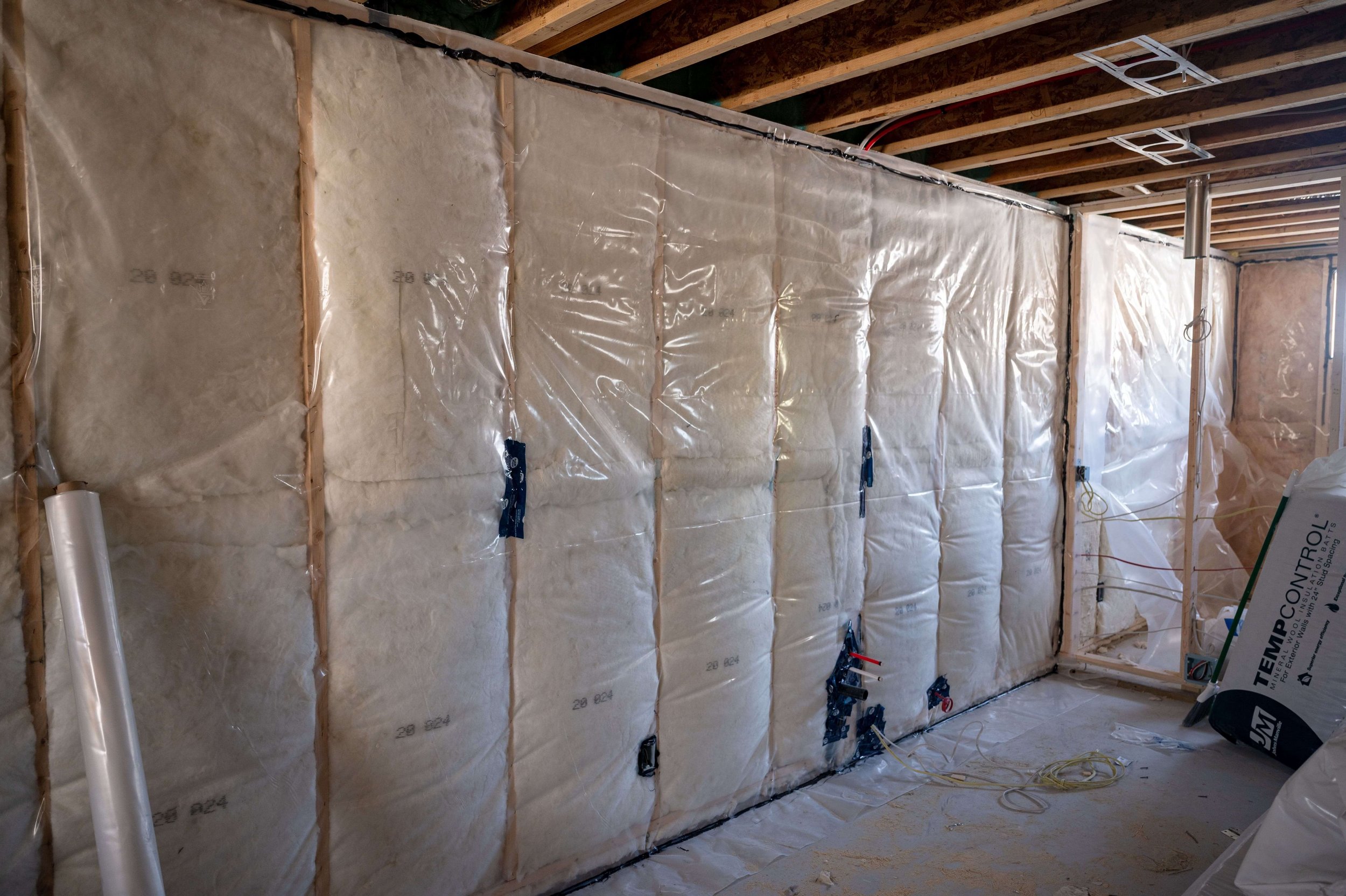Get Quality Insulation by Asking Us About Our Batt & Poly Insulation Options Today!
Batt fibreglass insulation is one of the best-known insulation materials. When used, polyethylene sheeting will be installed along with it to make a complete vapour barrier. It allows your insulation to retain its R-value, which is its ability to maintain temperature inside the building. Call the team at Great Canadian Insulation to learn more about the benefits of batt insulation with a poly vapour barrier!
Why Choose Great Canadian Insulation to Install Your Batt Insulation & Poly Vapour Barrier?
The team at Great Canadian Insulation is an experienced group of insulation contractors. We have many years of experience in the contracting and insulation industries. We ensure the job is done right when you choose us for your batt insulation and poly vapour barrier project.
We only use top-quality fibreglass for our batt insulation projects. It ensures that your building is protected from the outside air and moisture. Our vapour barriers are made from thick plastic sheets and protect your property from all weather conditions. This combination works together to keep your property safe and comfortable.
Our team can offer customized solutions to fulfill your insulation needs. Great Canadian Insulation contractors are committed to efficient service and customer satisfaction. Keeping you happy by fulfilling your needs is the best part of our job. We only leave once you're completely satisfied with our work.
Our Process
The team at Great Canadian Insulation has a thorough process for installing batt insulation and poly vapour barrier. Let us walk you through the installation from start to finish.
Consultation and Inspection
During your consultation, your contractor will work with you to determine where to insulate your property and what option is best for you. You will be given a proper estimate based on these factors and the inspection.
The process differs depending on the age of your building.
Here's what we do if you need help with your existing insulation. When inspecting your property, your contractor from Great Canadian Insulation will look for a few signs. The following can indicate the need for new insulation:
Holes in Exterior Walls: Weather conditions like hail and other accidents can damage your walls. They allow outside air to make its way into your building.
Bugs or Mice: If creatures make a home inside your walls, they can easily cause damage and deterioration over time. This can result in your home getting warmer or colder.
Moisture/Condensation: Puddles around the home and condensation on windows or doors can indicate poor insulation or exposed pipes.
Mould: Green, grey, or black splotches on the walls, floors, or insulation fibres are some things to be alarmed about. It can make you sick and damage your insulation.
High Energy Bills: If you have faulty insulation, your system will have to work harder to heat and cool your property. Call the professionals at Great Canadian Insulation to inspect this problem.
After your consultation and inspection, our team can give you a proper estimate for our services. Whether removing insulation or adding it to drywall in a new building, we're here for you. Call our team today!

Preparation
Your contractor will take a few steps to prepare before installing this type of insulation.
The first step is measuring the width of an exterior wall from inside the building. If the wall cavity is open, we will measure from the inside edge of one corner stud to the inside edge of the opposite corner stud. Then we measure the height of the wall from the top of the floor joist to the bottom of the ceiling joist. The measurements are multiplied to find the square footage of the wall.
Now, we measure the height and width of any windows and doors on the wall to find the area of each one. That total is subtracted from the first number to find the square footage of the wall to determine how much insulation is needed.
The previous steps are repeated for any other walls that need insulation. Adding all the numbers together will determine how much insulation is required for the property's exterior walls.
Finally, your contractor will measure the distance between one framing stud and the next to determine if they are 16 or 24 inches apart. It determines the width of batt insulation required.
If you already have insulation, your contractor will remove it to make room for your batt insulation and poly vapour barrier.
How It's Done
Let's review the steps of installing batt insulation with a poly vapour barrier.
Your contractor will begin by cutting the batt's width to line up one edge with the inside face of the stud bay.
Now, the insulation is trimmed to the proper length. It's done by tucking the insulation into the cavity against the top of the stud bay and edges flush with the studs. Letting the insulation run long and cutting it against the bottom plate of the wall framing ensures an accurate fit.
Your contractor may deal with some obstacles during installation, like electrical, plumbing, or HVAC systems. This is nothing new and the professionals at Great Canadian Insulation know exactly how to handle this situation. Halving the batt's thickness by pulling it apart, sliding one half behind the wire, and laying the other half in front is simple. Working the full thickness of the insulation behind plumbing supply pipes prevents them from freezing. With electrical boxes, your contractor will install the batt and cut a notch in its edge while using the notch as a guide.
Lastly, we add the poly vapour barrier. Batts with paper or foil have a retarder built in. Unfaced batts must be covered with 6-mil plastic,, also called a breathable sheet. Your contractor will apply a bead of sealant at the top and to the studs where the sheets overlap. Then we will tack the sheet every 12 to 24 inches to the top plate, studs, and bottom plate.
Efficiency Manitoba has rebates and offers to help.
All types of insulation can get rebates. The four types of rebates available are Home Insulation Rebate, Income Qualified Offers, First Nation Insulation and Direct Install, and Metis Energy Efficiency.
The team at Great Canadian Insulation will fill out the application for you and submit it for approval. A pre- and/or post-verification at your home may be required, but we’ll keep you informed of everything. Once we’ve finished the job and the insulation is fully installed and paid for, we submit the remaining paperwork on your behalf. We make it as easy as that. All you have to do is contact Great Canadian Insulation to see if you’re eligible today!

Great Canadian Insulation For Your insulation needs
The team at Great Canadian Insulation can't recommend batt insulation with a poly vapour barrier enough. It's an affordable insulation option that saves you money short- and long-term. The costs for materials are fairly low, and protecting your home from the elements lowers your energy bill. We also do Spray foam insulation, blown-in insulation for your attic and many more. Call the team of contractors at Great Canadian Insulation for a free estimate today!
Proud Members Of

Get in touch.
The team at Great Canadian Insulation offers insulation services in Winnipeg and surrounding areas. We use high-quality materials and will work within your budget. From spray foam to truck bedliners, we have you covered. Whether you're a home or business owner, we are happy to serve you. Do you have questions about any of our services? Call Great Canadian Insulation for a free estimate today! See our previous work.
Frequently Asked Questions
-
Batt insulation is one of the most common insulation types for commercial and residential properties. It's made from fibreglass and comes in rolls or pre-cut batts. It's used in walls, ceilings, floors, and attics to reduce heat transfer and improve energy efficiency. It traps air and slows down the transfer of heat.
-
A poly vapour barrier is a type of plastic sheeting that prevents moisture and vapour transmissions from entering a building. It stops condensation and moisture from causing mould and mildew growth. Both are hazardous to building materials. It keeps your home dry and free of moisture and vapour transmission.
What Our Clients Say About Us
“We ran into problems with our usual spray guy, right before farming season we needed 25 potato trailers done, GCI accommodated their schedule to help us out with our urgent matter. EXTREMELY recommend.”
“Not only did they help me out with removal of all my old insulation and application of new one, they also recommended me some guys they work with for general renovations and they were all fantastic.”
“We ran into problems with our usual spray It’s nearly impossible to find companies that will drive out as far as I need them to for my projects. The guys were willing to come out for a small travel fee and worked all day and night to get the job done extremely quick. ”
GET IN TOUCH
Where To Find Us
At Great Canadian Insulation, we are committed to providing high-quality insulation services at affordable prices. Whether you are a homeowner, or commercial property owner, live in Winnipeg, or the surrounding areas, we are happy to serve you. Get in touch with us today to learn more about how we can help.
Unit 2 - 30 Ryan Wirth Way, East St. Paul,
MB, Canada. R2E 1E8.
Hours
Monday–Friday
10am–6pm
Phone
+1 (204) 295-6244












